Things to do in Siem Reap
Though there are plenty of things to experience in Siem Reap, many top attractions lie just outside the city. The famous Angkor Archaeological Park is the most notable sightseeing destination. Stretching over 150 square miles (400 sq km), it houses some of the most important archaeological sites in Asia. More specifically, the park contains the magnificent remains of several buildings and monuments from the ancient Khmer Empire (9th to 15th century). The most famous sites include the Temple of Angkor Wat and the Bayon Temple. Adventurous travellers may want to visit temples like Beng Mealea, which nestles in the jungle. The Angkor temples can easily occupy visitors for several days, particularly as the Angkor Archaeological Park's landscapes are magnificent in and of themselves.
There are several notable tourist attractions within Siem Reap, including the Angkor National Museum, which is a useful complement to the archaeological wonders of the Angkor Temples. This modern museum is home to impressive galleries of artefacts taken from the temple complex. Another not-to-be-missed museum in Siem Reap is rather a different experience. Aki Ra's Landmine Museum lays out the modern strife of a country still struggling with landmines.
Visitors must be sure to visit Psar Chaa (the Old Market), a bustling collection of merchant stalls. This is a good venue for shopping and experiencing daily life in Siem Reap.
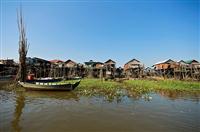
Villages on Stilts
Most tuk-tuk and moto drivers in Siem Reap will be only too happy to take you on a tour of one of the area's famous 'villages on stilts'. Many of the houses lining Tonle Sap Lake a…
Villages on Stilts
Most tuk-tuk and moto drivers in Siem Reap will be only too happy to take you on a tour of one of the area's famous 'villages on stilts'. Many of the houses lining Tonle Sap Lake are built on ten foot (3m) poles, so that when the water rises - as it does every year during the monsoon - the homes are not flooded or washed away. There are three main floating villages around Siem Reap located around the Tonle Sap Lank. The closest floating village is situated in Chong Khneas, just an hour's drive from Siem Reap. Villages closer to Siem Reap tend to be touristy, while those further away are far more picturesque and authentic.
A two-hour boat trip through Chong Khneas village costs about $8 per person or around $20 for a boatload. While the stilted homes are at their most practical during the wet season, the villages are most visually spectacular during the dry season, when their long stilts rise up eerily out of the mud or shallow water. Be aware that there have been tourist scams in the villages and that the poverty witnessed can be disturbing.
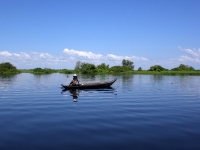
Tonlé Sap Lake
Boeung Tonlé Sap is one of the largest freshwater lakes in Asia. Containing a rich and diverse ecosystem, it's home to a wide array of fauna such as crocodiles, turtles, macaques …
Tonlé Sap Lake
Boeung Tonlé Sap is one of the largest freshwater lakes in Asia. Containing a rich and diverse ecosystem, it's home to a wide array of fauna such as crocodiles, turtles, macaques and otters. Villagers live in stilted or floating houses. The Prek Toal Bird Sanctuary in the Tonlé Sap Biosphere Reserve is home to ibis, stork, pelicans and fish eagles, all best viewed during the dry season. There is also a Tonlé Sap Exhibition in Siem Reap, showcasing Khmer heritage through a display of the local people's culture and environment. Boat tours on the lake are popular and an enthralling way to see the riverside villages and interact with the locals. It usually costs well under $20 to hire a boat and you can share it between a few people. Tips for the guides are also expected.
Address The lake is about nine miles (15km) south of Siem Reap
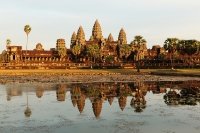
Temples of Angkor
The magnificent Temples of Angkor are iconic symbols of Cambodia, the spectacular complex a vivid vestige of the ancient Khmer Empire. Built between the 9th and 13th centuries, mor…
Temples of Angkor
The magnificent Temples of Angkor are iconic symbols of Cambodia, the spectacular complex a vivid vestige of the ancient Khmer Empire. Built between the 9th and 13th centuries, more than 100 temples have been uncovered as evidence of this impressive ancient civilisation and one of the biggest cities of its time. The complex's ancient ruins, well-preserved temples and stone monuments take a few days to explore in its entirety.
An impressive Hindu temple surrounded by a moat, Angkor Wat is the largest religious monument ever built and acknowledged as one among the greatest marvels of humankind. The walled Royal City of Angkor Thom is home to the Bayon Temple and its huge stone faces, another fascinating attraction.
If budget allows, visitors can see Angkor from the air in a hot air balloon or helicopter. It is particularly special to see the temple complex at sunrise and sunset, and it is best to avoid going during the midday heat. Also note that visitors are expected to dress respectfully and ticket vendors may refuse entry to those showing too much skin.
Address Three miles (5km) outside Siem Reap.
Opens Daily 5.30am-6pm.
Admission
$37 for 1 day ticket, $62 for 3 day ticket, $72 for 7 day ticket. Free for children under 12.
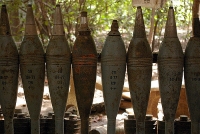
Aki Ra's Landmine Museum
The Aki Ra Museum provides a jarring counterpoint to the ancient Khmer glories on display at Angkor Wat, instead showcasing the more recent horrors of Cambodia's political and soci…
Aki Ra's Landmine Museum
The Aki Ra Museum provides a jarring counterpoint to the ancient Khmer glories on display at Angkor Wat, instead showcasing the more recent horrors of Cambodia's political and social upheavals. Founded by a former Khmer Rouge child soldier, the museum provides a clear and compelling account of this troubled time, and the appalling legacy of landmines and unexploded ordinance that remain a blight on the lives of Cambodian people. Despite ongoing efforts to find and defuse these sleeping weapons, it is estimated that about five million still remain. The museum teaches visitors how to recognise mines and what to do should they encounter them.
Address Located four miles (6km) south of Banteay Srey Temple, within the Angkor Wat Archaeological Park.
Website www.cambodialandminemuseum.org
Opens Open daily 7.30am-5pm.
Admission
$5 adult, free for children, other concessions available.
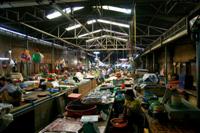
Psar Chaa (Old Market)
Psar Chaa, the Old Market, is Siem Reap's most popular shopping experience for visitors. Stalls sell all kinds of souvenirs including silk, carvings, stoneware and paintings, while…
Psar Chaa (Old Market)
Psar Chaa, the Old Market, is Siem Reap's most popular shopping experience for visitors. Stalls sell all kinds of souvenirs including silk, carvings, stoneware and paintings, while fresh produce and seafood stalls can be found inside. In fact, the market presents an excellent opportunity to sample all kinds of authentic Khmer food, invariably served with the distinctive local prahok, a type of fermented fish paste. A good accompaniment is coconut milk drunk directly from the fruit. The ubiquity of baguettes and frog legs is a delicious legacy of the French colonial era. Haggling is normal. So be patient, good-natured and maintain your sense of humour and you can get wonderful deals. The Old Market is central and conveniently located close to the river and the popular Pub Street.
Opens Daily 7am-8pm
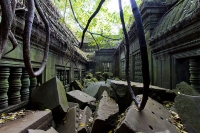
Beng Mealea
For those charmed by Ta Prom's jungle-clad stones within the Angkor Wat temple complex, it's well worth making the five-hour round trip to visit Beng Mealea, the ruins of an ancien…
Beng Mealea
For those charmed by Ta Prom's jungle-clad stones within the Angkor Wat temple complex, it's well worth making the five-hour round trip to visit Beng Mealea, the ruins of an ancient town centre. This little-visited sandstone temple, whose name means 'lotus pond', has now almost completely fused with the surrounding jungle. Built in the 12th century as a Hindu temple but long since abandoned, this sprawling complex is built in a similar style and scale to Angkor Wat. If you prefer to travel off the beaten track then Beng Mealea, overgrown and largely unrestored, will captivate you with its mystique and the relative freedom to explore its nooks and crannies.
Address 45 miles (70km) from Siem Reap
Opens Daily 7am-5.30pm
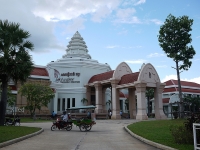
Angkor National Museum
The Angkor National Museum is an archaeological institution dedicated to the preservation and presentation of the Angkorian articles. A source of rich insight, it provides importan…
Angkor National Museum
The Angkor National Museum is an archaeological institution dedicated to the preservation and presentation of the Angkorian articles. A source of rich insight, it provides important historical, cultural and mythological context to the temple complex. Its fascinating treasures include the lion and demon heads missing from statues, Khmer artefacts predating the Angkor period and an enthralling collection of ancient Khmer and Sanskrit stone tablets. The museum also uses multimedia displays and various artefacts to evoke the golden age of Khmer culture. In addition to the entrance fee, and the optional extra cost for taking in a camera, visitors can pay for an educational audio tour.
Address No.968, Vithei Charles de Gaulle, Phoum Salakanseng, Khom Svaydangum, Siem Reap
Website www.angkornationalmuseum.com
Opens Daily 8.30am-6.30pm
Admission
$12 per person.



